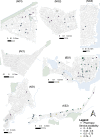Pharmacies in informal settlements: a retrospective, cross-sectional household and health facility survey in four countries
- PMID: 34503501
- PMCID: PMC8431901
- DOI: 10.1186/s12913-021-06937-9
Pharmacies in informal settlements: a retrospective, cross-sectional household and health facility survey in four countries
Abstract
Background: Slums or informal settlements characterize most large cities in LMIC. Previous evidence suggests pharmacies may be the most frequently used source of primary care in LMICs but that pharmacy services are of variable quality. However, evidence on pharmacy use and availability is very limited for slum populations.
Methods: We conducted household, individual, and healthcare provider surveys and qualitative observations on pharmacies and pharmacy use in seven slum sites in four countries (Nigeria, Kenya, Pakistan, and Bangladesh). All pharmacies and up to 1200 households in each site were sampled. Adults and children were surveyed about their use of healthcare services and pharmacies were observed and their services, equipment, and stock documented.
Results: We completed 7692 household and 7451 individual adults, 2633 individual child surveys, and 157 surveys of pharmacies located within the seven sites. Visit rates to pharmacies and drug sellers varied from 0.1 (Nigeria) to 3.0 (Bangladesh) visits per person-year, almost all of which were for new conditions. We found highly variable conditions in what constituted a "pharmacy" across the sites and most pharmacies did not employ a qualified pharmacist. Analgesics and antibiotics were widely available but other categories of medications, particularly those for chronic illness were often not available anywhere. The majority of pharmacies lacked basic equipment such as a thermometer and weighing scales.
Conclusions: Pharmacies are locally and widely available to residents of slums. However, the conditions of the facilities and availability of medicines were poor and prices relatively high. Pharmacies may represent a large untapped resource to improving access to primary care for the urban poor.
Keywords: Healthcare access; LMICs; Pharmacies; Slums; Welfare.
© 2021. The Author(s).
Conflict of interest statement
None declared.
Figures




References
-
- UN Habitat. The challenge of the slums: global report on human settlements 2003. London; 2010. https://unhabitat.org/the-challenge-of-slums-global-report-on-human-sett....
-
- Ezeh A, Oyebode O, Satterthwaite D, Chen Y-F, Ndugwa R, Sartori J, Mberu B, Melendez-Torres GJ, Haregu T, Watson SI, Caiaffa W, Capon A, Lilford RJ. The history, geography, and sociology of slums and the health problems of people who live in slums. Lancet. 2017;389(10068):547–558. doi: 10.1016/S0140-6736(16)31650-6. - DOI - PubMed
-
- Lilford RJ, Oyebode O, Satterthwaite D, Melendez-Torres GJ, Chen Y-F, Mberu B, Watson SI, Sartori J, Ndugwa R, Caiaffa W, Haregu T, Capon A, Saith R, Ezeh A. Improving the health and welfare of people who live in slums. Lancet. 2017;389(10068):559–570. doi: 10.1016/S0140-6736(16)31848-7. - DOI - PubMed
-
- Lilford R, Kyobutungi C, Ndugwa R, Sartori J, Watson SI, Sliuzas R, Kuffer M, Hofer T, Porto de Albuquerque J, Ezeh A. Because space matters: conceptual framework to help distinguish slum from non-slum urban areas. BMJ Glob Heal. 2019;4(2):e001267. doi: 10.1136/bmjgh-2018-001267. - DOI - PMC - PubMed
-
- WHO. UNICEF Declaration of Astanap.8–9. Declaration of Astana. Glob Conf Prim Heal Care. 2018. https://www.who.int/docs/default-source/primary-health/declaration/gcphc....
MeSH terms
LinkOut - more resources
Full Text Sources

